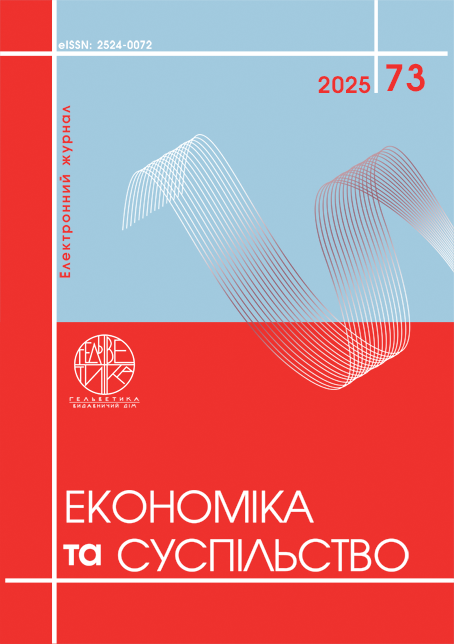ТРАНСФЕР ТЕХНОЛОГІЙ ЯК ПРИХОВАНИЙ МЕХАНІЗМ ВЕНЧУРНОГО ІНВЕСТУВАННЯ ІННОВАЦІЙНИХ СТАРТАПІВ
Анотація
У статті досліджено трансфер технологій як прихований механізм венчурного інвестування інноваційних стартапів, що функціонує на ранніх етапах розвитку проєкту у форматі немонетарної підтримки. Обґрунтовано, що передача нематеріальних активів (прав інтелектуальної власності, доступу до інфраструктури, експертного супроводу, менторства, включення в партнерські мережі) формує первинну інвестиційну спроможність проєкту. Побудовано авторську модель структурованої інституційної участі без прямого фінансування, а також етапну схему трансферу як логіки формування венчурної вартості. Виокремлено економічні риси трансферу, притаманні венчурному капіталу: ризик, очікувана віддача, стратегічний інтерес, складність монетизації. Зроблено акцент на потребі включення трансферу до державної політики інноваційного розвитку як специфічного інструменту підтримки стартапів у фазі pre-seed. Визначено перспективи подальших досліджень.
Посилання
Бєлялов Т. Е., Гірник Я. С. Стартап-проєкт як форма розвиту інноваційного підприємництва. Journal of strategic economic research. 2024. № 2. С. 8–15. URL: https://doi.org/10.30857/2786-5398.2024.2.1 (дата звернення: 28.04.2025).
Bellucci A., Gucciardi G., Nepelski D. Public grants beneficiaries and venture capital-backed firms: a tale of two funding strategies. The journal of technology transfer. 2025. URL: https://doi.org/10.1007/s10961-024-10180-9 (date of access: April 28, 2025).
Borrás S., Gerli F., Cenzato R. Technology transfer offices in the diffusion of transformative innovation: rethinking roles, resources, and capabilities. Technological forecasting and social change. 2024. Vol. 200. Art. 123157. URL: https://doi.org/10.1016/j.techfore.2023.123157 (date of access: April 28, 2025).
Dyba M. Infrastructure of startups’ venture financing. Actual problems of economics. 2024. Vol. 1. No. 278. С. 192–199. URL: https://doi.org/10.32752/1993-6788-2024-1-278-192-199 (date of access: April 28, 2025).
Eidlisz J., von Simson I., Gold-von Simson G. Exploring the current state of technology transfer in the United States: perspectives and improvement strategies from the experts. Frontiers in research metrics and analytics. 2024. Vol. 9. URL: https://doi.org/10.3389/frma.2024.1376185 (date of access: April 28, 2025).
Hong J., Cha J., Park B., Park K. Evaluation framework for facilitating the technology transfers of universities: focusing on the perspective of technology donors. PLOS ONE. 2023. Vol. 18. No. 12. Art. e0293951. URL: https://doi.org/10.1371/journal.pone.0293951 (date of access: April 28, 2025).
Kirihata T. Impact of technology transfer offices on university spin-off bankruptcy. The journal of technology transfer. 2024. URL: https://doi.org/10.1007/s10961-024-10129-y (date of access: April 28, 2025).
Kruger S., Steyn A. A. Enhancing technology transfer through entrepreneurial development: practices from innovation spaces. The journal of technology transfer. 2019. Vol. 45. No. 6. С. 1655–1689. URL: https://doi.org/10.1007/s10961-019-09769-2 (date of access: April 28, 2025).
Martínez-Ardila H., Castro-Rodriguez Á., Camacho-Pico J. Examining the impact of university-industry collaborations on spin-off creation: evidence from joint patents. Heliyon. 2023. Vol. 9. No. 9. Art. e19533. URL: https://doi.org/10.1016/j.heliyon.2023.e19533 (date of access: April 28, 2025).
Rozghon O. Technology transfer mechanism and its implementation in the innovation process. Law and innovations. No. 1(37), 2022. С. 22–30. URL: https://doi.org/10.37772/2518-1718-2022-1(37)-3 (date of access: April 28, 2025).
Startups and innovation ecosystems in emerging markets / ed. by M. d. M. Oliveira, F. R. Cahen, F. M. Borini. Cham : Springer International Publishing, 2019. URL: https://doi.org/10.1007/978-3-030-10865-6 (date of access: April 28, 2025).
Veer T., Yang P., Riepe J. Ventures' conscious knowledge transfer to close partners, and beyond: a framework of performance, complementarity, knowledge disclosure, and knowledge broadcasting. Journal of business venturing. 2022. Vol. 37. No. 3. Art. 106191. URL: https://doi.org/10.1016/j.jbusvent.2022.106191 (date of access: April 28, 2025).
Bielialov, T. E., & Hirnyk, Ya. S. (2024). Startap-proiekt yak forma rozvytku innovatsiinoho pidpryiemnytstva [Startup project as a form of innovative entrepreneurship development]. Journal of Strategic Economic Research, (2), pp. 8–15. https://doi.org/10.30857/2786-5398.2024.2.1 (accessed April 28, 2025).
Bellucci, A., Gucciardi, G., & Nepelski, D. (2025). Public grants beneficiaries and venture capital-backed firms: A tale of two funding strategies. The Journal of Technology Transfer. https://doi.org/10.1007/s10961-024-10180-9 (accessed April 28, 2025).
Borrás, S., Gerli, F., & Cenzato, R. (2024). Technology transfer offices in the diffusion of transformative innovation: Rethinking roles, resources, and capabilities. Technological Forecasting and Social Change, 200, 123157. https://doi.org/10.1016/j.techfore.2023.123157 (accessed April 28, 2025).
Dyba, M. (2024). Infrastructure of startups’ venture financing. Actual Problems of Economics, 1(278), pp. 192–199. https://doi.org/10.32752/1993-6788-2024-1-278-192-199 (accessed April 28, 2025).
Eidlisz, J., von Simson, I., & Gold-von Simson, G. (2024). Exploring the current state of technology transfer in the United States: Perspectives and improvement strategies from the experts. Frontiers in Research Metrics and Analytics, 9. https://doi.org/10.3389/frma.2024.1376185 (accessed April 28, 2025).
Hong, J., Cha, J., Park, B., & Park, K. (2023). Evaluation framework for facilitating the technology transfers of universities: Focusing on the perspective of technology donors. PLOS ONE, 18(12), e0293951. https://doi.org/10.1371/journal.pone.0293951 (accessed April 28, 2025).
Kirihata, T. (2024). Impact of technology transfer offices on university spin-off bankruptcy. The Journal of Technology Transfer. https://doi.org/10.1007/s10961-024-10129-y (accessed April 28, 2025).
Kruger, S., & Steyn, A. A. (2019). Enhancing technology transfer through entrepreneurial development: Practices from innovation spaces. The Journal of Technology Transfer, 45(6), pp. 1655–1689. https://doi.org/10.1007/s10961-019-09769-2 (accessed April 28, 2025).
Martínez-Ardila, H., Castro-Rodriguez, Á., & Camacho-Pico, J. (2023). Examining the impact of university-industry collaborations on spin-off creation: Evidence from joint patents. Heliyon, 9(9), e19533. https://doi.org/10.1016/j.heliyon.2023.e19533 (accessed April 28, 2025).
Oliveira, M. d. M., Cahen, F. R., & Borini, F. M. (Eds.). (2019). Startups and innovation ecosystems in emerging markets. Springer International Publishing. https://doi.org/10.1007/978-3-030-10865-6 (accessed April 28, 2025).
Rozghon, O. (2022). Technology transfer mechanism and its implementation in the innovation process. Law and Innovations, 1(37), pp. 22–30. https://doi.org/10.37772/2518-1718-2022-1(37)-3 (accessed April 28, 2025).
Veer, T., Yang, P., & Riepe, J. (2022). Ventures’ conscious knowledge transfer to close partners, and beyond: A framework of performance, complementarity, knowledge disclosure, and knowledge broadcasting. Journal of Business Venturing, 37(3), 106191. https://doi.org/10.1016/j.jbusvent.2022.106191 (accessed April 28, 2025).

Ця робота ліцензується відповідно до Creative Commons Attribution 4.0 International License.


